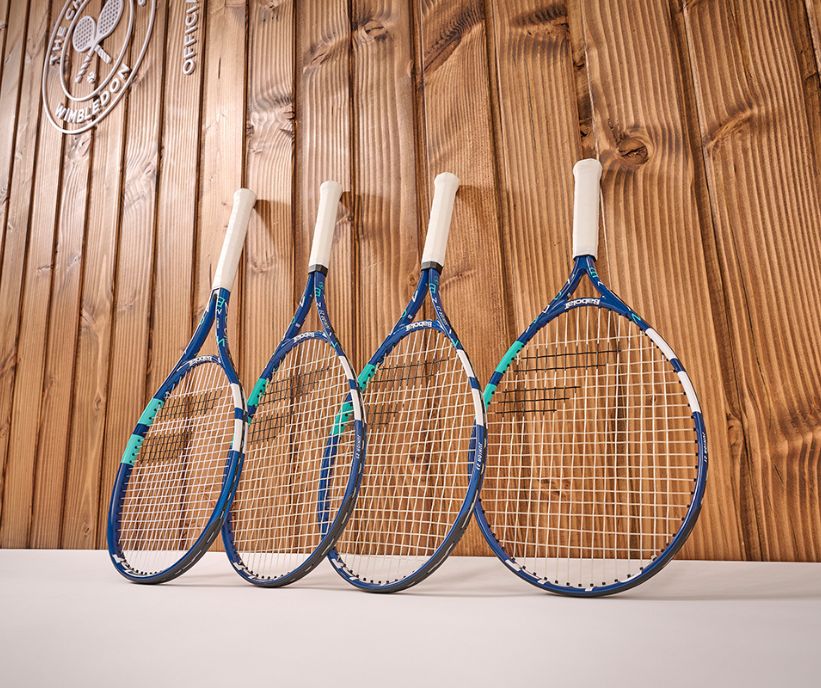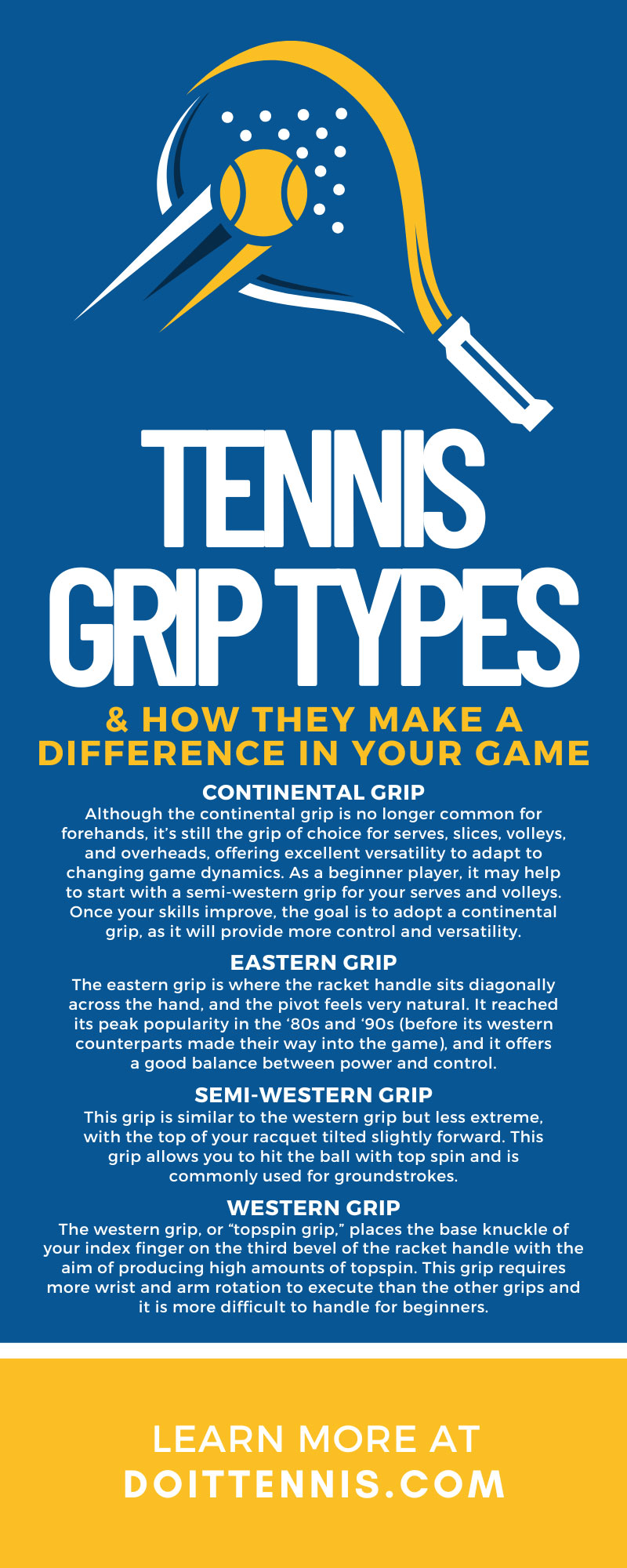Tennis Grip Types & How They Make a Difference in Your Game
May 24th, 2024 by Do It Tennis

Tennis beginners and experts alike know that the equipment they use during a match plays a very important role in improving performance. Your racquet is your partner, and how you hold it directly affects how well you’re able to hit the ball.
Whether you're serving or rallying with your opponent from the baseline, having the right grip can make a huge difference in how well you hit each shot. We’ll explore the various types of tennis grips and how they affect your performance.
The Importance of Proper Tennis Grip
If you’re new to the sport, a tennis grip might seem like a small detail. However, after your first lesson, you’ll quickly realize that it’s an essential component of your game. A proper tennis grip is critical because it acts as a conduit for your energy and movement. It’s also essential for comfort and injury prevention.
Using the wrong grip can lead to undue stress on your wrist, arm, and shoulder. Conversely, a well-chosen grip will help you generate spin, control the ball, and even add power to your shots. As such, understanding and choosing the right grip is as important as any other foundational skill in tennis.
Detailed Breakdown of Each Grip
There are several different ways to hold a tennis racquet, and each of them has its own set of benefits and drawbacks depending on your style. Here are some of the most common tennis grip types and how they make a difference in your game.
Continental Grip
Until the mid-1970s, the continental grip was a very popular grip for forehands. However, once top spin became crucial to the game, most players adopted a semi-western grip.
Although the continental grip is no longer common for forehands, it’s still the grip of choice for serves, slices, volleys, and overheads, offering excellent versatility to adapt to changing game dynamics. As a beginner player, it may help to start with a semi-western grip for your serves and volleys. Once your skills improve, the goal is to adopt a continental grip, as it will provide more control and versatility.
To use the continental grip, hold the racquet perpendicular to the ground and place the first knuckle of your index finger over the second bevel along the handle. From here, wrap your remaining fingers around the handle. You can move your index finger up the handle during play to increase control and provide more power.
Eastern Grip
The eastern grip is where the racket handle sits diagonally across the hand, and the pivot feels very natural. It reached its peak popularity in the ‘80s and ‘90s (before its western counterparts made their way into the game), and it offers a good balance between power and control.
The eastern grip is still a popular choice among some recreational players and is primarily used for forehand shots. It's considered a neutral grip because it allows you to hit flat and control the ball well, but still hit with more spin than the continental grip.
Semi-Western Grip
Taking the middle ground between the eastern and western grips is the semi-western grip. It's a staple (and most popular) for the modern baseline player, offering a balanced mix of power and spin.
This grip is similar to the western grip but less extreme, with the top of your racquet tilted slightly forward. This grip allows you to hit the ball with top spin and is commonly used for groundstrokes.
Western Grip
The western grip, or “topspin grip,” places the base knuckle of your index finger on the third bevel of the racket handle with the aim of producing high amounts of topspin. This grip requires more wrist and arm rotation to execute than the other grips and it is more difficult to handle for beginners.
It's also known as the “King of Spin” grip because it allows for the rotation of the strings around the ball, which produces the familiar heavy spin and keeps the ball dipping sharply.
How To Determine the Right Grip for Your Game
Choosing the right grip for your groundstrokes requires a balance of comfort, control, and how much topspin vs. power you want to hit with. The continental grip is optimal for long-term performance and versatility during serves and volleys. Here are some steps to help you find your most suitable grip for your groundstrokes.
Factors To Consider
- Comfort level: The grip must feel natural and comfortable in your hand. You shouldn't have to grip the racket too tightly or feel pain or strain during play.
- Spin vs. flat shots: Depending on your playstyle, you may prefer to hit with more spin or more flat shots. A western or semi-western grip will allow you to hit with more spin, while an eastern grip is more suitable for flat shots. Try different grips if you’re not happy with yours and see which feels more natural to your game. Note that you can always use slight variations of all the grips mentioned above. Do what feels right for you.
Tips for Experimenting With Grips
- Try a variety of grips: Spend time practicing with different grips, from eastern to western and semi-western, to understand how they affect your game and the ball’s movement as it leaves your racquet.
- Seek guidance: A coach can provide valuable insight into your grip and offer advice on adjustments if necessary. Sometimes, even a small tweak can make a significant difference in your game.
- Practice consistently: To make a grip adjustment permanent, practice regularly with the new grip. Muscle memory takes time to develop, and consistent practice helps the new grip become more natural.
Common Mistakes To Avoid When Adjusting Grips
Adjusting your grip can be tricky, and there are common pitfalls to avoid in the process.
Overgripping
Holding the racket too tightly can hinder how much power you put into shots and make you susceptible to injuries. This can commonly occur when you're trying out a new grip, so put extra effort into holding your racquet with the same level of strength you always use.
Ignoring Discomfort
While a new grip may feel odd at first, it shouldn't cause discomfort or pain. If it does, it's a sign that the grip might not be right for you or that your technique needs refinement. Don’t try to push through this feeling, as it can worsen your symptoms or lead to a serious injury in the future.
Skipping the Basics
Perfecting your grip is essential, but don't forget about other aspects of your game, such as footwork and body positioning. All elements must work in harmony, and you should practice them alongside your grip adjustments.
As shown above, there are many tennis grip types that can make a difference in your game. Altering your tennis grip might just be the game-changer you've been looking for. It's worth the time and effort to understand how different grips can transform your play.
Just keep in mind that it may require time and patience to make the full adjustment. The key is to experiment, be patient, and seek guidance from a coach. With practice, patience, and the right grip, you'll find new levels of control and power in your game that you never thought possible.
Our team at Do It Tennis has a steadfast commitment to helping you succeed on the court. Whether you’re looking for top-of-the-line gear or simply need some advice, we’re the perfect resource for tennis players looking to improve. Shop our collection of Yonex tennis racquets for sale among many other leading brands. We’re confident that we have just the thing to take your game to the next level.



